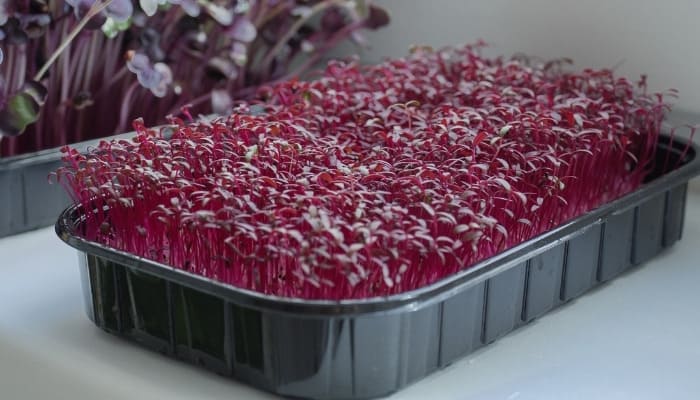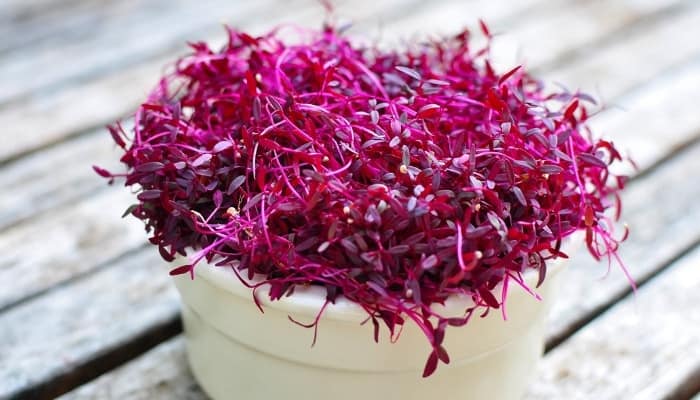Despite not being widely recognized, Amaranth microgreens are actually one of the top secret superfoods available.
How do you grow amaranth microgreens? Amaranth microgreens can be grown in soil or in trays without soil. Give the seeds plenty of moisture, darkness, and warmth to germinate them quickly. Once sprouted, give them light, water, and several days. Harvest when they are tall/big enough for your tastes.
Read on below and explore everything you need to know about getting started!
Amaranth Microgreens
Microgreens grown from amaranth seed are a highly underrated and often overlooked superfood. Amaranth microgreens are high in fiber, vitamins, minerals, and protein.
Basically, they provide most of what your body needs to stay healthy. In the following sections, we discuss these extremely healthy microgreens in much greater detail.
What Are Amaranth Microgreens Good For?
These microgreens are good for immune and digestive systems, metabolizing fatty acids into energy, and so much more.
- Supplement your diet
- Improve immune system
- Boost recovery speeds
- Improve eyesight
- Activate digestion system
- Act as an antioxidant
- Decrease graying hair and hair loss
- Metabolize fatty acids
- Work against osteoporosis
- Decrease hunger
Are Amaranth Microgreens Healthy?
Amaranth microgreens are entirely healthy. As far as microgreens go, they are one of the best species you can grow/eat.
Not only are they a major fiber and protein source, but they’re also gluten free.
The microgreens contain vitamins A, C, and E, as well as amino acids, phosphorus, potassium, calcium, iron, magnesium, folate, lysine, and other essential minerals.
Is Amaranth a Superfood?
Amaranth microgreens are definitely superfoods. These microgreens have enough good stuff in them to keep your body healthy and functioning optimally.
That said, they are seriously overlooked and underrated, even a basic protein and fiber source, let alone as a superfood.
Amaranth Microgreen Benefits
The benefits of growing/eating amaranth microgreens are legion.
They are:
- Affordable to grow
- One of the easiest microgreens to grow
- Packed with fiber and protein
- Loaded with essential vitamins
- Loaded with essential minerals
- Helpful to the immune and digestive system
- Useful in fighting cancer and other illnesses
- Helpful for body functions like improving eyesight and preventing hair loss
What Do Amaranth Microgreens Taste Like?
Amaranth microgreens are reported to be mildly earthy, yet reminiscent of spinach, with just a bit of sweetness and spiciness to them.
Texture-wise, they are tender but crisp. They are an excellent snack, as an ingredient, or as/in a salad.
How Do You Eat Red Amaranth Microgreens?
Red amaranth microgreens are regularly eaten in several different ways. Perhaps the most popular way of eating them is in a salad or by adding them to burgers and sandwiches.
Another common way to eat these microgreens is as a garnish on just about anything you make.
Just keep in mind that cooking them causes up to 50% of the nutritional value to disappear.

Amaranth Microgreen Recipes
There are an endless amount of ways to eat your amaranth microgreens. Your personal tastes and creative skills in the kitchen are the only limit to the ways you can eat them.
Here are a few of our favorite simple amaranth microgreen recipes:
Salad
There is no right or wrong way to make a salad with amaranth microgreens. That said, we enjoy adding alfalfa, clover, broccoli, and amaranth microgreens together with a dash of salt and lime.
Squash & Amaranth Soup
Looking for something a bit more substantial than salad? Why not try a soup of butternut squash and a dash of red amaranth microgreens? Add a dash of salt and pepper, and you’re good to go!
Corn Kiribath (Milk Rice)
If you know how to prepare milk rice, you’re going to love this one: prepare corn kiribath as normal; just be sure to use basmati rice, coconut milk, water, and red amaranth in addition to minor spices like salt.
Baked Broccoli and Black Bean Noodles
This is one that can be done in several different ways, depending on your tastes. For example, black bean noodles can be replaced with your favorite kind.
The most important thing is to use red amaranth microgreens, tahini, cucumber, yogurt, and baked broccoli as the core ingredients!
How Long Does Amaranth Take To Sprout?
Depending on the species/seeds, amaranth typically requires around 4 or 5 to germinate/sprout, though 10 days is not uncommon.
If planting and growing them outdoors in the ground, expect a bit longer of a germination period.
Is Amaranth Hard To Grow?
Believe it or not, this little superfood is one of the very easiest microgreens to grow that there is.
That said, just make sure they stay somewhere warm and full of light and have well-drained soil. Also, you’ll want to water them up to two or three times per week during peek warm periods.
Are Red Garnet Amaranth Microgreens Edible?
Red garnet amaranth microgreens are just as edible as any species. In fact, they are even tastier than most of the amaranth microgreens out there.
The best time to harvest this particular type of amaranth is 2 to 3 weeks after planting.
What Is the Best Variety of Amaranth for Microgreens?
Many microgreen growers commonly point to the red garnet species as the best variety of amaranth to grow as microgreens.
They are super easy to grow, extremely healthy for you, and are the most beautiful to look at as well with their red/purple tops.
How To Grow Amaranth Microgreens
Amaranth microgreens are among the easiest microgreens to grow and are relatively easier to grow than “normal” plants too!
Here’s how you do it, step-by-step:
- Secure the proper seeds
- Fill trays with water
- Add growing medium until the water is mostly absorbed
- Spread the seeds out over the growing medium
- Mist the seeds with a water bottle or sprayer
- Once the seeds germinate, add light to the mix
- Continue watering daily
- Harvest once the microgreens are about 3 inches tall
Tip: Use a germination heat mat (I recommend this one) under your tray to speed sprouting.
How To Grow Amaranth Microgreens Without Soil
Growing amaranth microgreens without soil isn’t much different of a process than growing them with soil.
The biggest difference is getting used to the fact that, yes, things can grow and thrive without dirt!
Here are the steps:
- Purchase amaranth seeds
- Fill your tray with water
- Add in the seeds
- Once they sprout and have two little leaves, add light
- Continue watering for several more days
- Harvest once they reach a height of approximately 3 inches
As with growing microgreens in soil, adding a warming mat under the tray helps speed up the germination process.
Conclusion
Amaranth microgreens are an excellent choice for beginners and long-time microgreen growers/consumers alike.
Not only are they healthier than most and easy to grow, but they are also prettier to look at! So, what’s not to like?
Whether you plan to grow in soil or in soilless trays/mediums, hopefully, we answered all of your questions!

